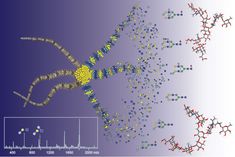Two recent studies published in JBC, from the Molecular Glycobiology & Glycophylogeny group, headed by Iain Wilson, at the Department of Chemistry, address this gap in the knowledge of carbohydrate structures within these animals. The results obtained after purification using liquid chromatography and analysis using mass spectrometry and chemical and enzymatic treatments showed a wealth of hybrid and complex oligosaccharide structures reminiscent of those in higher vertebrates as well as some classical invertebrate glycan structures. The high degree of modification of the N-linked glycans with negatively charged groups, coupled with species-specific motifs, is a hint that sugar chains may be responsible for reproductive isolation and speciation. The studies also indicate the power of isomeric glycan analysis using off-line MALDI-TOF MS based on the accumulated experience of the postdoctoral FWF Fellows in the group.
Sulfated and sialylated N-glycans in the echinoderm Holothuria atra reflect its marine habitat and phylogeny
Jorick Vanbeselaere, Chunsheng Jin, Barbara Eckmair, Iain B. H. Wilson and Katharina Paschinger
J. Biol. Chem. 2020; 295:3159-3172 First Published On January 22, 2020. doi:10.1074/jbc.RA119.011701[Abstract][Full Text][Supporting Information][PDF]
Glycosylation at an evolutionary nexus: the brittle star Ophiactis savignyi expresses both vertebrate and invertebrate N-glycomic features
Barbara Eckmair, Chunsheng Jin, Niclas G. Karlsson, Daniel Abed-Navandi, Iain B. H. Wilson and Katharina Paschinger
J. Biol. Chem. 2020; 295:3173-3188 First Published On January 30, 2020. doi:10.1074/jbc.RA119.011703[Abstract][Full Text][Supporting Information][PDF]

